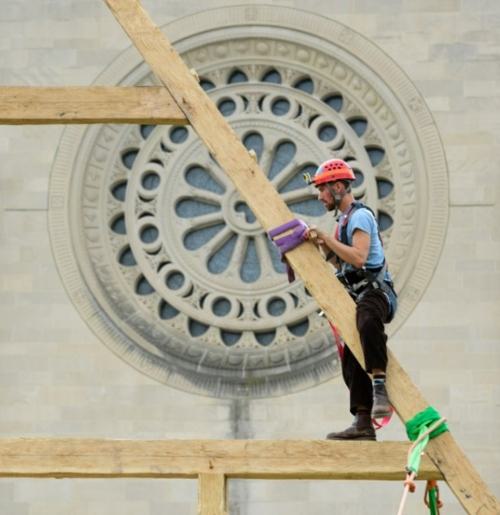"Posterity: All succeeding generations: future time"
—Webster’s Third New International Dictionary of the English Language, unabridged (1981)
April 15, 2019 marked a pivotal event in the history of Notre-Dame Cathedral in Paris when a blazing fire burnt down its roof, spire, and caused intense damage throughout the structure. The destruction created a lively debate in academic, professional, and civic circles about the nature of the reconstruction. Would the Cathedral simply be rebuilt or redesigned?
In favor of the latter, some thought that the fire had provided an opportunity to make a new mark on the building, something expressive of the present age. Proposals for the new roof rolled out in quick succession. Some imagined it to become an urban farm, a glass spire, and even a swimming pool.
In addition to disregarding the actual purpose of the Cathedral, these proposals failed to heed the value of what had protected the Cathedral for almost 800 years. They were rooted in nothing but current architectural fads.
The original roof played a decisive role in the perception of the Cathedral throughout Paris. Supported by a series of timber trusses, composed of 1,300 White Oak logs, the roof was a testament to medieval craftmanship and engineering. Through a process of notching, juggling, and hewing using a variety of axes, medieval carpenters had sized the logs according to their purpose, and then used mortise and tenon joinery to structurally bind the individual timbers into a truss.
For us beginners, we had the added challenge of not having hands callused from years of wielding an axe. Thus, our hands were battered by the end, covered in blisters, tears, and blood.
Thankfully, in July of 2020, the French National Commission for Heritage and Architecture (CNPA) accepted plans to, “respect the previously existing structure of the Cathedral and to restore the monument to its last complete, coherent and known state.”
This decision presented architects and craftsmen with a novel opportunity: to re-discover the enduring appeal of Notre-Dame’s medieval features, the genius of those who built it and the stewardship of those who cared for it. Just as there were many people eager to redesign Notre-Dame, there were many eager to rebuild it. Scholars, architects, conservators, and craftsmen had gained an intricate understanding of the methods required to complete such an undertaking after years spent studying and documenting the Cathedral’s existing conditions in detailed drawings before the fire. They had a roadmap for bringing Notre-Dame back to her former self.
It may come as a surprise to many that the knowledge, skill, and resolve to rebuild Notre-Dame as it was before the fire still exists. Indeed, timber framing, which makes use of techniques that have been passed down and which have evolved over millennia, is one of many traditional crafts that is still thriving. It is, and has always been, used in the building of things that last. Those who would rebuild Notre-Dame, therefore, would not be reviving extinct or even outdated technologies. Rather, they would place themselves in a living tradition of construction technology, one that has been preserved and maintained since antiquity.
That living tradition was on display at The Catholic University of America in the summer of 2021 when its School of Architecture and Planning and Handshouse Studio collaborated to bring together professional timber framers from around the United States and Catholic University students to build a choir truss from Notre-Dame, using only 13th-century construction techniques.
I was privileged to participate in this project as a student in the School of Architecture. In preparation for the project my classmates and I took a six-week course on the history and architecture of Notre-Dame. We were given lectures on medieval engineering, the documentation of the Cathedral by conservators, the development and utilization of medieval timber framing, and on the historical context in which the Cathedral was built. We were then familiarized with woodworking and put through a series of model building exercises. Looking at drawings of Notre-Dame provided by French architects, we built individual models of the truss at a fiftieth of its size and then six as a class at a tenth of its size. In this way we became familiar with the types of joinery we would be using when we built the truss at full size.
The truss was to be about 40 feet wide by 30 feet tall. White Oak logs, felled in Virginia, were delivered by truck onto the lawn of the Basilica of the Immaculate Conception. Each log was identified to serve a specific purpose based on its length and width. We were then broken down into groups—students mixed with professionals. The professionals introduced the students to the different types of axes, their purposes, and the proper way to use them. We began to turn the logs into timbers. First, we marked the logs with chalk to indicate the final dimensions of the timbers. We then notched the logs, by standing on top of them and swinging a felling axe in a downward motion to cut a series of “V” shapes at evenly spaced intervals. Next, we juggled the logs, by standing on top of the log and swinging the axe parallel to its length, to remove material between the “V”-shaped cut outs, thus getting us one step closer to a flat surface and the required dimension of the timber. Finally, we hewed the logs. This was the most time-consuming step because of the accuracy required. Using a broad axe, we straddled the log and swung from waist high to more accurately remove any remaining material. This was done along the entire length of the log until it was plumb with the chalk line.
The encouragement and confidence we were given by the professionals onsite allowed us to begin working independently on logs that still needed to be turned into timbers. So, a group of students marked out a log, notched, juggled, and hewed it until it was ready to be used. This allowed the framers to apply mortise and tenon joinery to the finished timbers in order to assemble the truss.
The project was physically taxing and time consuming, especially as it was done in the early August heat and humidity of Washington, D.C. We often started our days at 6:30 a.m. and worked until 6 p.m. For us beginners, we had the added challenge of not having hands callused from years of wielding an axe. Thus, our hands were battered by the end, covered in blisters, tears, and blood. But it was rewarding. The whole group started by meeting and recapping the previous day’s progress and reviewing what work was left to do. Under the shadow of the Basilica, our days were filled with the rhythmic noise of axes striking wood and punctuated every 15 minutes by the bells of the Basilica tolling in the background.
There was an undeniable excitement on the work site, and it buzzed with activity. We were all working together to contribute a small piece to the larger picture of rebuilding Notre Dame. Besides the truss, we hoped our contribution showed that it was possible to rebuild the Cathedral as it was, that there were people excited to do so, and that traditional building crafts are accessible no matter a person’s previous experience.
After 10 days the truss was assembled and raised into an upright position twice, once on the lawn of the Basilica of the Immaculate Conception and another on the National Mall. Since the completion of the project in the summer of 2021, Handshouse has continued to promote the project and plans to release a documentary. A trailer can be seen here. Additionally, in September of 2022 Philippe Villeneuve and Remi Fromont, the Chief Architects of the restoration of Notre-Dame, came to Catholic University to view a raising of the truss, followed by lectures and discussions at the university.
Meanwhile in France, in the time since the fire at Notre-Dame, work has continued nonstop. In 2021 the Cathedral went through a safety phase, ensuring that the building was stabilized, until the site was suitable for future work. During that time, 1,000 oak trees were felled to be used in the future spire and roof of Notre-Dame. Currently, those trees are in workshops around France being brought to the specified size for their designated use by timber framers for future work on the Cathedral.
To see Notre-Dame brought back to its former self is exciting for scholars, architects, and craftsmen around the world. They find themselves inserted in a living tradition. The Cathedral was built for posterity’s sake. The builders who began the work of constructing it knew that they would never enjoy the fruits of their own labor. Their initiative, offered to the glory of God, was a gift to future generations. To have done anything but honor their gift would have been nothing but ingratitude towards those who have gone before us and impoverish those who will succeed us.
The rebuilding of Notre Dame speaks to the importance that beautiful, meaningful places maintain in our lives and the professionals that stand ready to dedicate their time and expertise when necessary. It is a reminder of why we have an affinity for buildings. Beholding them we are reminded that they were conceived by a human mind, crafted by human hands, and created for a human purpose. To deny the world the opportunity to look upon Notre Dame as others have for centuries would be an injustice.



